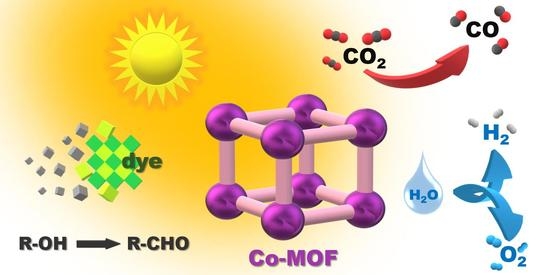Insight into the Photocatalytic Activity of Cobalt-Based Metal–Organic Frameworks and Their Composites
Abstract
:1. Introduction
2. Photocatalytic Degradation of Dyes
3. Photocatalytic Reactions with Water
3.1. Photocatalytic Water Oxidation
3.2. Photocatalytic Water Splitting
4. Photocatalytic Carbon Dioxide Reduction
5. Photocatalytic Oxidation of Organic Compounds
6. Conclusions
Author Contributions
Funding
Conflicts of Interest
References
- Dawood, F.; Anda, M.; Shafiullah, G.M. Hydrogen production for energy: An overview. Int. J. Hydrogen Energy 2020, 45, 3847–3869. [Google Scholar] [CrossRef]
- Jain, I.P. Hydrogen the fuel for 21st century. Int. J. Hydrogen Energy 2009, 34, 7368–7378. [Google Scholar] [CrossRef]
- De Richter, R.; Ming, T.; Davies, P.; Liu, W.; Caillol, S. Removal of non-CO2 greenhouse gases by large-scale atmospheric solar photocatalysis. Prog. Energy Combust. Sci. 2017, 60, 68–96. [Google Scholar] [CrossRef]
- Manan, Z.A.; Mohd Nawi, W.N.R.; Wan Alwi, S.R.; Klemeš, J.J. Advances in Process Integration research for CO2 emission reduction—A review. J. Clean. Prod. 2017, 167, 1–13. [Google Scholar] [CrossRef]
- Vasseghian, Y.; Khataee, A.; Dragoi, E.N.; Moradi, M.; Nabavifard, S.; Oliveri Conti, G.; Mousavi Khaneghah, A. Pollutants degradation and power generation by photocatalytic fuel cells: A comprehensive review. Arab. J. Chem. 2020, 13, 8458–8480. [Google Scholar] [CrossRef]
- Saeed, M.; Muneer, M.; ul Haq, A.; Akram, N. Photocatalysis: An effective tool for photodegradation of dyes—A review. Environ. Sci. Pollut. Res. 2021, 29, 293–311. [Google Scholar] [CrossRef]
- Wang, Q.; Domen, K. Particulate Photocatalysts for Light-Driven Water Splitting: Mechanisms, Challenges, and Design Strategies. Chem. Rev. 2020, 120, 919–985. [Google Scholar] [CrossRef]
- Zhao, W.; Chen, Z.; Yang, X.; Qian, X.; Liu, C.; Zhou, D.; Sun, T.; Zhang, M.; Wei, G.; Dissanayake, P.D.; et al. Recent advances in photocatalytic hydrogen evolution with high-performance catalysts without precious metals. Renew. Sustain. Energy Rev. 2020, 132, 110040. [Google Scholar] [CrossRef]
- Ismael, M. A review and recent advances in solar-to-hydrogen energy conversion based on photocatalytic water splitting over doped-TiO2 nanoparticles. Sol. Energy 2020, 211, 522–546. [Google Scholar] [CrossRef]
- Lin, S.; Huang, H.; Ma, T.; Zhang, Y. Photocatalytic Oxygen Evolution from Water Splitting. Adv. Sci. 2021, 8, 2002458. [Google Scholar] [CrossRef]
- White, J.L.; Baruch, M.F.; Pander, J.E.; Hu, Y.; Fortmeyer, I.C.; Park, J.E.; Zhang, T.; Liao, K.; Gu, J.; Yan, Y.; et al. Light-Driven Heterogeneous Reduction of Carbon Dioxide: Photocatalysts and Photoelectrodes. Chem. Rev. 2015, 115, 12888–12935. [Google Scholar] [CrossRef]
- Xu, S.; Carter, E.A. Theoretical Insights into Heterogeneous (Photo)electrochemical CO2 Reduction. Chem. Rev. 2019, 119, 6631–6669. [Google Scholar] [CrossRef]
- Wenderich, K.; Mul, G. Methods, Mechanism, and Applications of Photodeposition in Photocatalysis: A Review. Chem. Rev. 2016, 116, 14587–14619. [Google Scholar] [CrossRef] [PubMed]
- Wuttke, S. Introduction to Reticular Chemistry. Metal–Organic Frameworks and Covalent Organic Frameworks by Omar M. Yaghi, Markus J. Kalmutzki, and Christian S. Diercks.; John Wiley & Sons: Hoboken, NJ, USA, 2019; Volume 58, ISBN 3527345027. [Google Scholar]
- Hwang, J.; Ejsmont, A.; Freund, R.; Goscianska, J.; Schmidt, B.V.K.J.; Wuttke, S. Controlling the morphology of metal-organic frameworks and porous carbon materials: Metal oxides as primary architecture-directing agents. Chem. Soc. Rev. 2020, 49, 3348–3422. [Google Scholar] [CrossRef] [PubMed]
- Ejsmont, A.; Andreo, J.; Lanza, A.; Galarda, A.; Macreadie, L.; Wuttke, S.; Canossa, S.; Ploetz, E.; Goscianska, J. Applications of reticular diversity in metal–organic frameworks: An ever-evolving state of the art. Coord. Chem. Rev. 2021, 430, 213655. [Google Scholar] [CrossRef]
- Freund, R.; Zaremba, O.; Arnauts, G.; Ameloot, R.; Skorupskii, G.; Dincă, M.; Bavykina, A.; Gascon, J.; Ejsmont, A.; Goscianska, J.; et al. The Current Status of MOF and COF Applications. Angew. Chem. Int. Ed. 2021, 60, 23975–24001. [Google Scholar] [CrossRef] [PubMed]
- Furukawa, H.; Cordova, K.E.; O’Keeffe, M.; Yaghi, O.M. The chemistry and applications of metal-organic frameworks. Science 2013, 341, 1230444. [Google Scholar] [CrossRef] [Green Version]
- Hao, Y.-C.; Chen, L.-W.; Li, J.; Guo, Y.; Su, X.; Shu, M.; Zhang, Q.; Gao, W.-Y.; Li, S.; Yu, Z.-L.; et al. Metal-organic framework membranes with single-atomic centers for photocatalytic CO2 and O2 reduction. Nat. Commun. 2021, 12, 2682. [Google Scholar] [CrossRef]
- Su, Y.; Song, Z.; Zhu, W.; Mu, Q.; Yuan, X.; Lian, Y.; Cheng, H.; Deng, Z.; Chen, M.; Yin, W.; et al. Visible-Light Photocatalytic CO2 Reduction Using Metal-Organic Framework Derived Ni(OH)2 Nanocages: A Synergy from Multiple Light Reflection, Static Charge Transfer, and Oxygen Vacancies. ACS Catal. 2021, 11, 345–354. [Google Scholar] [CrossRef]
- Kalaj, M.; Cohen, S.M. Postsynthetic Modification: An Enabling Technology for the Advancement of Metal-Organic Frameworks. ACS Cent. Sci. 2020, 6, 1046–1057. [Google Scholar] [CrossRef]
- Ma, S.; Zhou, H.C. A metal-organic framework with entatic metal centers exhibiting high gas adsorption affinity. J. Am. Chem. Soc. 2006, 128, 11734–11735. [Google Scholar] [CrossRef] [PubMed]
- Au, V.K.M. Recent Advances in the Use of Metal-Organic Frameworks for Dye Adsorption. Front. Chem. 2020, 8, 708. [Google Scholar] [CrossRef] [PubMed]
- Mandade, P. Introduction, basic principles, mechanism, and challenges of photocatalysis. In Handbook of Nanomaterials for Wastewater Treatment; Elsevier: Amsterdam, The Netherlands, 2021; pp. 137–154. [Google Scholar]
- Li, X.; Yu, J.; Gosztola, D.J.; Fry, H.C.; Deria, P. Wavelength-Dependent Energy and Charge Transfer in MOF: A Step toward Artificial Porous Light-Harvesting System. J. Am. Chem. Soc. 2019, 141, 16849–16857. [Google Scholar] [CrossRef] [PubMed]
- Xiao, T.; Zhong, W.; Zhou, L.; Xu, L.; Sun, X.Q.; Elmes, R.B.P.; Hu, X.Y.; Wang, L. Artificial light-harvesting systems fabricated by supramolecular host–guest interactions. Chin. Chem. Lett. 2019, 30, 31–36. [Google Scholar] [CrossRef]
- Zhao, X.; Song, X.; Li, Y.; Chang, Z.; Chen, L. Targeted Construction of Light-Harvesting Metal-Organic Frameworks Featuring Efficient Host-Guest Energy Transfer. ACS Appl. Mater. Interfaces 2018, 10, 5633–5640. [Google Scholar] [CrossRef]
- Whelan, É.; Steuber, F.W.; Gunnlaugsson, T.; Schmitt, W. Tuning photoactive metal–organic frameworks for luminescence and photocatalytic applications. Coord. Chem. Rev. 2021, 437, 213757. [Google Scholar] [CrossRef]
- Xiao, J.D.; Jiang, H.L. Metal-Organic Frameworks for Photocatalysis and Photothermal Catalysis. Acc. Chem. Res. 2018, 52, 356–366. [Google Scholar] [CrossRef]
- Mandal, S.; Natarajan, S.; Mani, P.; Pankajakshan, A. Post-Synthetic Modification of Metal–Organic Frameworks toward Applications. Adv. Funct. Mater. 2021, 31, 2006291. [Google Scholar] [CrossRef]
- Yin, Z.; Wan, S.; Yang, J.; Kurmoo, M.; Zeng, M.-H. Recent advances in post-synthetic modification of metal–organic frameworks: New types and tandem reactions. Coord. Chem. Rev. 2019, 378, 500–512. [Google Scholar] [CrossRef]
- Zhong, G.; Liu, D.; Zhang, J. The application of ZIF-67 and its derivatives: Adsorption, separation, electrochemistry and catalysts. J. Mater. Chem. A 2018, 6, 1887–1899. [Google Scholar] [CrossRef]
- Chen, H.; Zhang, Z.; Hu, D.; Chen, C.; Zhang, Y.; He, S.; Wang, J. Catalytic ozonation of norfloxacin using Co3O4/C composite derived from ZIF-67 as catalyst. Chemosphere 2021, 265, 129047. [Google Scholar] [CrossRef]
- Sayahi, M.H.; Ghomi, M.; Hamad, S.M.; Ganjali, M.R.; Aghazadeh, M.; Mahdavi, M.; Bahadorikhalili, S. Electrochemical synthesis of three-dimensional flower-like Ni/Co–BTC bimetallic organic framework as heterogeneous catalyst for solvent-free and green synthesis of substituted chromeno[4,3–b]quinolones. J. Chin. Chem. Soc. 2021, 68, 620–629. [Google Scholar] [CrossRef]
- Wu, Y.; Song, X.; Xu, S.; Zhang, J.; Zhu, Y.; Gao, L.; Xiao, G. 2-Methylimidazole Modified Co-BTC MOF as an Efficient Catalyst for Chemical Fixation of Carbon Dioxide. Catal. Lett. 2019, 149, 2575–2585. [Google Scholar] [CrossRef]
- Liu, Q.; Zhang, L.Y.; Bao, Y.M.; Zhang, N.; Zhang, J.Y.; Xing, Y.Y.; Deng, W.; Liu, Z.J. Structures and catalytic oxidative coupling reaction of four Co-MOFs modified with R-isophthalic acid (R=H, OH and COOH) and trigonal ligands. CrystEngComm 2021, 23, 7590–7601. [Google Scholar] [CrossRef]
- Yang, M.X.; Chen, L.J.; Ye, Y.Z.; Lin, X.Y.; Lin, S. Four 3D Co(ii) MOFs based on 2,4,6-tris(4-pyridyl)-1,3,5-triazine and polycarboxylic acid ligands and their derivatives as efficient electrocatalysts for oxygen reduction reaction. Dalt. Trans. 2021, 50, 4904–4913. [Google Scholar] [CrossRef]
- Huang, C.; Gu, X.; Su, X.; Xu, Z.; Liu, R.; Zhu, H. Controllable synthesis of Co-MOF-74 catalysts and their application in catalytic oxidation of toluene. J. Solid State Chem. 2020, 289, 121497. [Google Scholar] [CrossRef]
- Dhakshinamoorthy, A.; Lanzuela, E.M.; Navalon, S.; Garcia, H. Cobalt-based metal organic frameworks as solids catalysts for oxidation reactions. Catalysts 2021, 11, 95. [Google Scholar] [CrossRef]
- Sun, K.K.; Sun, J.L.; Lu, G.P.; Cai, C. Enhanced catalytic activity of cobalt nanoparticles encapsulated with an N-doped porous carbon shell derived from hollow ZIF-8 for efficient synthesis of nitriles from primary alcohols in water. Green Chem. 2019, 21, 4334–4340. [Google Scholar] [CrossRef]
- Shen, K.; Chen, X.; Chen, J.; Li, Y. Development of MOF-Derived Carbon-Based Nanomaterials for Efficient Catalysis. ACS Catal. 2016, 6, 5887–5903. [Google Scholar] [CrossRef]
- Jagadeesh, R.V.; Murugesan, K.; Alshammari, A.S.; Neumann, H.; Pohl, M.M.; Radnik, J.; Beller, M. MOF-derived cobalt nanoparticles catalyze a general synthesis of amines. Science 2017, 358, 326–332. [Google Scholar] [CrossRef] [Green Version]
- Zhang, M.; Xiao, C.; Zhang, C.; Qi, J.; Wang, C.; Sun, X.; Wang, L.; Xu, Q.; Li, J. Large-Scale Synthesis of Biomass@MOF-Derived Porous Carbon/Cobalt Nanofiber for Environmental Remediation by Advanced Oxidation Processes. ACS ES&T Eng. 2021, 1, 249–260. [Google Scholar] [CrossRef]
- Phillips, C. Cobalt MOF-5: A Novel Catalyst for CO2 Conversion to Carbonates; University of Louisville: Louisville, KY, USA, 2012. [Google Scholar]
- Xu, Y.; Zhang, F.; Sheng, T.; Ye, T.; Yi, D.; Yang, Y.; Liu, S.; Wang, X.; Yao, J. Clarifying the controversial catalytic active sites of Co3O4 for the oxygen evolution reaction. J. Mater. Chem. A 2019, 7, 23191–23198. [Google Scholar] [CrossRef]
- Artero, V.; Chavarot-Kerlidou, M.; Fontecave, M. Splitting water with cobalt. Angew. Chem. Int. Ed. 2011, 50, 7238–7266. [Google Scholar] [CrossRef]
- Natali, M.; Luisa, A.; Iengo, E.; Scandola, F. Efficient photocatalytic hydrogen generation from water by a cationic cobalt (II) porphyrin. Chem. Commun. 2014, 50, 1842–1844. [Google Scholar] [CrossRef] [PubMed]
- Zhang, W.; Huang, R.; Song, L.; Shi, X. Cobalt-based metal-organic frameworks for the photocatalytic reduction of carbon dioxide. Nanoscale 2021, 13, 9075–9090. [Google Scholar] [CrossRef] [PubMed]
- Maeda, K.; Domen, K. Photocatalytic water splitting: Recent progress and future challenges. J. Phys. Chem. Lett. 2010, 1, 2655–2661. [Google Scholar] [CrossRef]
- Ali, M.; Pervaiz, E.; Noor, T.; Rabi, O.; Zahra, R.; Yang, M. Recent advancements in MOF-based catalysts for applications in electrochemical and photoelectrochemical water splitting: A review. Int. J. Energy Res. 2021, 45, 1190–1226. [Google Scholar] [CrossRef]
- Shi, Y.; Yang, A.-F.; Cao, C.-S.; Zhao, B. Applications of MOFs: Recent advances in photocatalytic hydrogen production from water. Coord. Chem. Rev. 2019, 390, 50–75. [Google Scholar] [CrossRef]
- Tasleem, S.; Tahir, M.; Khalifa, W.A. Current trends in structural development and modification strategies for metal-organic frameworks (MOFs) towards photocatalytic H2 production: A review. Int. J. Hydrogen Energy 2021, 46, 14148–14189. [Google Scholar] [CrossRef]
- Dhakshinamoorthy, A.; Asiri, A.M.; García, H. Metal-Organic Framework (MOF) Compounds: Photocatalysts for Redox Reactions and Solar Fuel Production. Angew. Chem. Int. Ed. 2016, 55, 5414–5445. [Google Scholar] [CrossRef]
- Li, X.; Zhu, Q.L. MOF-based materials for photo- and electrocatalytic CO2 reduction. EnergyChem 2020, 2, 100033. [Google Scholar] [CrossRef]
- Liu, C.; Wang, W.; Liu, B.; Qiao, J.; Lv, L.; Gao, X.; Zhang, X.; Xu, D.; Liu, W.; Liu, J.; et al. Recent advances in MOF-based nanocatalysts for photo-promoted CO2 reduction applications. Catalysts 2019, 9, 658. [Google Scholar] [CrossRef] [Green Version]
- Gautam, S.; Agrawal, H.; Thakur, M.; Akbari, A.; Sharda, H.; Kaur, R.; Amini, M. Metal oxides and metal organic frameworks for the photocatalytic degradation: A review. J. Environ. Chem. Eng. 2020, 8, 103726. [Google Scholar] [CrossRef]
- Belousov, A.S.; Suleimanov, E.V. Application of metal-organic frameworks as an alternative to metal oxide-based photocatalysts for the production of industrially important organic chemicals. Green Chem. 2021, 23, 6172–6204. [Google Scholar] [CrossRef]
- Wang, Q.; Gao, Q.; Al-Enizi, A.M.; Nafady, A.; Ma, S. Recent advances in MOF-based photocatalysis: Environmental remediation under visible light. Inorg. Chem. Front. 2020, 7, 300–339. [Google Scholar] [CrossRef]
- Melchionna, M.; Fornasiero, P. Updates on the Roadmap for Photocatalysis. ACS Catal. 2020, 10, 5493–5501. [Google Scholar] [CrossRef] [Green Version]
- Xu, Y.-J. Promises and Challenges in Photocatalysis. Front. Catal. 2021, 1, 6. [Google Scholar] [CrossRef]
- Liu, H.; Zhang, J.; Lu, M.; Liang, L.; Zhang, H.; Wei, J. Biosynthesis based membrane filtration coupled with iron nanoparticles reduction process in removal of dyes. Chem. Eng. J. 2020, 387, 124202. [Google Scholar] [CrossRef]
- Joseph, J.; Radhakrishnan, R.C.; Johnson, J.K.; Joy, S.P.; Thomas, J. Ion-exchange mediated removal of cationic dye-stuffs from water using ammonium phosphomolybdate. Mater. Chem. Phys. 2020, 242, 122488. [Google Scholar] [CrossRef]
- Goscianska, J.; Ciesielczyk, F. Lanthanum enriched aminosilane-grafted mesoporous carbon material for efficient adsorption of tartrazine azo dye. Microporous Mesoporous Mater. 2019, 280, 7–19. [Google Scholar] [CrossRef]
- Ghuge, S.P.; Saroha, A.K. Catalytic ozonation of dye industry effluent using mesoporous bimetallic Ru-Cu/SBA-15 catalyst. Process Saf. Environ. Prot. 2018, 118, 125–132. [Google Scholar] [CrossRef]
- Shiva Shankar, Y.; Ankur, K.; Bhushan, P.; Mohan, D. Utilization of Water Treatment Plant (WTP) Sludge for Pretreatment of Dye Wastewater Using Coagulation/Flocculation. In Advances in Waste Management; Springer: Singapore, 2019; pp. 107–121. [Google Scholar]
- Golmohammadi, M.; Honarmand, M.; Ghanbari, S. A green approach to synthesis of ZnO nanoparticles using jujube fruit extract and their application in photocatalytic degradation of organic dyes. Spectrochim. Acta Part A Mol. Biomol. Spectrosc. 2020, 229, 117961. [Google Scholar] [CrossRef] [PubMed]
- Anwer, H.; Mahmood, A.; Lee, J.; Kim, K.-H.; Park, J.-W.; Yip, A.C.K. Photocatalysts for degradation of dyes in industrial effluents: Opportunities and challenges. Nano Res. 2019, 12, 955–972. [Google Scholar] [CrossRef]
- Reddy, C.V.; Reddy, K.R.; Harish, V.V.N.; Shim, J.; Shankar, M.V.; Shetti, N.P.; Aminabhavi, T.M. Metal-organic frameworks (MOFs)-based efficient heterogeneous photocatalysts: Synthesis, properties and its applications in photocatalytic hydrogen generation, CO2 reduction and photodegradation of organic dyes. Int. J. Hydrogen Energy 2020, 45, 7656–7679. [Google Scholar] [CrossRef]
- Rafiq, A.; Ikram, M.; Ali, S.; Niaz, F.; Khan, M.; Khan, Q.; Maqbool, M. Photocatalytic degradation of dyes using semiconductor photocatalysts to clean industrial water pollution. J. Ind. Eng. Chem. 2021, 97, 111–128. [Google Scholar] [CrossRef]
- Tran, N.T.; Trung, L.G.; Nguyen, M.K. The degradation of organic dye contaminants in wastewater and solution from highly visible light responsive ZIF-67 monodisperse photocatalyst. J. Solid State Chem. 2021, 300, 122287. [Google Scholar] [CrossRef]
- Yuan, C.; Cheng, P.; Li, J.; Gao, X.; Gao, X.; Wang, X.; Jin, M.; Nötzel, R.; Zhou, G.; Zhang, Z.; et al. ZIF-67 with Argon annealing treatment for visible light responsive degradation of organic dyes in a wide pH range. Microporous Mesoporous Mater. 2019, 285, 13–20. [Google Scholar] [CrossRef]
- Flihh, S.M.; Ammar, S.H. Fabrication and photocatalytic degradation activity of core/shell ZIF-67@CoWO4@CoS heterostructure photocatalysts under visible light. Environ. Nanotechnol. Monit. Manag. 2021, 16, 100595. [Google Scholar] [CrossRef]
- Nguyen, T.N.; Nguyen, H.P.; Kim, T.H.; Lee, S.W. Bimetallic Co/Zn-ZIF as an efficient photocatalyst for degradation of indigo carmine. Korean J. Mater. Res. 2018, 28, 68–74. [Google Scholar] [CrossRef]
- Cui, G.; Liu, W.; Wang, L.; Wu, R.; Bi, C.; Zhang, D.; Fan, Y. Two novel Co (II) bifunctional MOFs: Syntheses and applications in photocatalytic degradation of dyes and electrocatalytic water oxidation. J. Solid State Chem. 2021, 304, 122562. [Google Scholar] [CrossRef]
- Zhang, X.; Meng, X.; Wang, J.; Ji, Z.; Lu, P.; Wang, X.; Chen, F. Rational design of two novel metal–organic frameworks as photocatalysts for degradation of organic dyes and their derived materials as electrocatalysts for OER. Inorg. Chim. Acta 2021, 523, 120416. [Google Scholar] [CrossRef]
- Wang, J.; Zhou, S.; Chen, C.; Lu, L.; Li, B.; Hu, W.; Kumar, A.; Muddassir, M. Two new uncommon 3D cobalt-based metal organic frameworks: Temperature induced syntheses and enhanced photocatalytic properties against aromatic dyes. Dye. Pigment. 2021, 187, 109068. [Google Scholar] [CrossRef]
- Yang, Y.; Fu, P.; Li, X.; Su, Z.M.; Xu, N.; Wang, X. long Co-based MOF for efficient degradation of RB in aqueous solutions by peroxymonosulfate activation. Inorg. Chem. Commun. 2020, 122, 108282. [Google Scholar] [CrossRef]
- Wu, R.; Bi, C.; Zhang, X.; Wang, J.; Wang, L.; Fan, C.; Wang, M.; Shao, F.; Li, N.; Zong, Z.; et al. Construction of two cobalt based bi-functional metal-organic frameworks for enhancing electrocatalytic water oxidation and photocatalytic disposals of hazardous aromatic dyes. Mol. Catal. 2021, 505, 111450. [Google Scholar] [CrossRef]
- El-Fawal, E.M.; Abd El Salam, H.M. Deposition of dyes on Cobalt-based metal-organic framework (Co-MOF) composites with promoted achievement photocatalytic degradation of an anionic dye (EBT) under visible light irradiation. Int. J. Environ. Anal. Chem. 2020. [Google Scholar] [CrossRef]
- Li, J.X.; Qin, Z.B.; Li, Y.H.; Cui, G.H. Visible-light-driven photocatalyst for the degradation of methylene blue over a 3D cobalt(II)-4,4′-oxybis(benzoate) framework. Inorg. Chem. Commun. 2018, 90, 112–114. [Google Scholar] [CrossRef]
- Chen, J.; Xing, Z.; Han, J.; Su, M.; Li, Y.; Lu, A. Enhanced degradation of dyes by Cu-Co-Ni nanoparticles loaded on amino-modified octahedral metal–organic framework. J. Alloys Compd. 2020, 834, 155106. [Google Scholar] [CrossRef]
- Guo, X.; Liu, L.; Xiao, Y.; Mehmood, R.; Xiao, Y.; Qi, Y.; Zhang, F. Water-Stable Cobalt-Based MOF for Water Oxidation in Neutral Aqueous Solution: A Case of Mimicking the Photosystem II. Inorg. Chem. 2021, 60, 1790–1796. [Google Scholar] [CrossRef] [PubMed]
- Hernández-Alonso, M.D.; Fresno, F.; Suárez, S.; Coronado, J.M. Development of alternative photocatalysts to TiO2: Challenges and opportunities. Energy Environ. Sci. 2009, 2, 1231–1257. [Google Scholar] [CrossRef]
- Huang, G.-F.; Ma, Z.-L.; Huang, W.-Q.; Tian, Y.; Jiao, C.; Yang, Z.-M.; Wan, Z.; Pan, A. Semiconductor Photocatalyst: Possibilities and Challenges. J. Nanomater. 2013, 2013, 371356. [Google Scholar] [CrossRef] [Green Version]
- Yemmireddy, V.K.; Hung, Y.-C. Using Photocatalyst Metal Oxides as Antimicrobial Surface Coatings to Ensure Food Safety-Opportunities and Challenges. Compr. Rev. Food Sci. Food Saf. 2017, 16, 617–631. [Google Scholar] [CrossRef] [Green Version]
- Sohrabi, S.; Keshavarz Moraveji, M.; Iranshahi, D. A review on the design and development of photocatalyst synthesis and application in microfluidic reactors: Challenges and opportunities. Rev. Chem. Eng. 2020, 36, 687–722. [Google Scholar] [CrossRef]
- Kallawar, G.A.; Barai, D.P.; Bhanvase, B.A. Bismuth titanate based photocatalysts for degradation of persistent organic compounds in wastewater: A comprehensive review on synthesis methods, performance as photocatalyst and challenges. J. Clean. Prod. 2021, 318, 128563. [Google Scholar] [CrossRef]
- Chen, S.; Huang, D.; Xu, P.; Xue, W.; Lei, L.; Cheng, M.; Wang, R.; Liu, X.; Deng, R. Semiconductor-based photocatalysts for photocatalytic and photoelectrochemical water splitting: Will we stop with photocorrosion? J. Mater. Chem. A 2020, 8, 2286–2322. [Google Scholar] [CrossRef]
- Liu, B.; Li, J.; Wu, H.-L.; Liu, W.-Q.; Jiang, X.; Li, Z.-J.; Chen, B.; Tung, C.-H.; Wu, L.-Z. Improved Photoelectrocatalytic Performance for Water Oxidation by Earth-Abundant Cobalt Molecular Porphyrin Complex-Integrated BiVO4 Photoanode. ACS Appl. Mater. Interfaces 2016, 8, 18577–18583. [Google Scholar] [CrossRef]
- Soni, V.; Xia, C.; Cheng, C.K.; Nguyen, V.-H.; Nguyen, D.L.T.; Bajpai, A.; Kim, S.Y.; Van Le, Q.; Khan, A.A.P.; Singh, P.; et al. Advances and recent trends in cobalt-based cocatalysts for solar-to-fuel conversion. Appl. Mater. Today 2021, 24, 101074. [Google Scholar] [CrossRef]
- Maeda, K.; Ishimaki, K.; Tokunaga, Y.; Lu, D.; Eguchi, M. Modification of Wide-Band-Gap Oxide Semiconductors with Cobalt Hydroxide Nanoclusters for Visible-Light Water Oxidation. Angew. Chem. Int. Ed. 2016, 55, 8309–8313. [Google Scholar] [CrossRef]
- Maity, K.; Bhunia, K.; Pradhan, D.; Biradha, K. Co(II)-Doped Cd-MOF as an Efficient Water Oxidation Catalyst: Doubly Interpenetrated Boron Nitride Network with the Encapsulation of Free Ligand Containing Pyridine Moieties. ACS Appl. Mater. Interfaces 2017, 9, 37548–37553. [Google Scholar] [CrossRef] [PubMed]
- Wang, C.; Xie, Z.; Dekrafft, K.E.; Lin, W. Doping metal-organic frameworks for water oxidation, carbon dioxide reduction, and organic photocatalysis. J. Am. Chem. Soc. 2011, 133, 13445–13454. [Google Scholar] [CrossRef] [PubMed]
- Lionet, Z.; Kim, T.-H.; Horiuchi, Y.; Lee, S.W.; Matsuoka, M. Linker Engineering of Iron-Based MOFs for Efficient Visible-Light-Driven Water Oxidation Reaction. J. Phys. Chem. C 2019, 123, 27501–27508. [Google Scholar] [CrossRef]
- Dong, Y.-J.; Liao, J.-F.; Kong, Z.-C.; Xu, Y.-F.; Chen, Z.-J.; Chen, H.-Y.; Kuang, D.-B.; Fenske, D.; Su, C.-Y. Conformal coating of ultrathin metal-organic framework on semiconductor electrode for boosted photoelectrochemical water oxidation. Appl. Catal. B Environ. 2018, 237, 9–17. [Google Scholar] [CrossRef]
- Younus, H.A.; Ahmad, N.; Chughtai, A.H.; Vandichel, M.; Busch, M.; Van Hecke, K.; Yusubov, M.; Song, S.; Verpoort, F. A Robust Molecular Catalyst Generated In Situ for Photo- and Electrochemical Water Oxidation. ChemSusChem 2017, 10, 862–875. [Google Scholar] [CrossRef]
- Hong, D.; Jung, J.; Park, J.; Yamada, Y.; Suenobu, T.; Lee, Y.M.; Nam, W.; Fukuzumi, S. Water-soluble mononuclear cobalt complexes with organic ligands acting as precatalysts for efficient photocatalytic water oxidation. Energy Environ. Sci. 2012, 5, 7606–7616. [Google Scholar] [CrossRef]
- Liu, S.; Lei, Y.J.; Xin, Z.J.; Xiang, R.J.; Styring, S.; Thapper, A.; Wang, H.Y. Ligand modification to stabilize the cobalt complexes for water oxidation. Int. J. Hydrogen Energy 2017, 42, 29716–29724. [Google Scholar] [CrossRef]
- Luo, H.; Zeng, Z.; Zeng, G.; Zhang, C.; Xiao, R.; Huang, D.; Lai, C.; Cheng, M.; Wang, W.; Xiong, W.; et al. Recent progress on metal-organic frameworks based- and derived-photocatalysts for water splitting. Chem. Eng. J. 2020, 383, 123196. [Google Scholar] [CrossRef]
- Huang, N.Y.; Shen, J.Q.; Ye, Z.M.; Zhang, W.X.; Liao, P.Q.; Chen, X.M. An exceptionally stable octacobalt-cluster-based metal-organic framework for enhanced water oxidation catalysis. Chem. Sci. 2019, 10, 9859–9864. [Google Scholar] [CrossRef] [PubMed] [Green Version]
- Shah, W.A.; Waseem, A.; Nadeem, M.A.; Kögerler, P. Leaching-free encapsulation of cobalt-polyoxotungstates in MIL-100 (Fe) for highly reproducible photocatalytic water oxidation. Appl. Catal. A Gen. 2018, 567, 132–138. [Google Scholar] [CrossRef]
- Han, J.; Wang, D.; Du, Y.; Xi, S.; Hong, J.; Yin, S.; Chen, Z.; Zhou, T.; Xu, R. Metal-organic framework immobilized cobalt oxide nanoparticles for efficient photocatalytic water oxidation. J. Mater. Chem. A 2015, 3, 20607–20613. [Google Scholar] [CrossRef]
- Paille, G.; Gomez-Mingot, M.; Roch-Marchal, C.; Lassalle-Kaiser, B.; Mialane, P.; Fontecave, M.; Mellot-Draznieks, C.; Dolbecq, A. A Fully Noble Metal-Free Photosystem Based on Cobalt-Polyoxometalates Immobilized in a Porphyrinic Metal-Organic Framework for Water Oxidation. J. Am. Chem. Soc. 2018, 140, 3613–3618. [Google Scholar] [CrossRef] [PubMed] [Green Version]
- Paille, G.; Gomez-Mingot, M.; Roch-Marchal, C.; Haouas, M.; Benseghir, Y.; Pino, T.; Ha-Thi, M.H.; Landrot, G.; Mialane, P.; Fontecave, M.; et al. Thin Films of Fully Noble Metal-Free POM@MOF for Photocatalytic Water Oxidation. ACS Appl. Mater. Interfaces 2019, 11, 47837–47845. [Google Scholar] [CrossRef]
- Guo, C.; Guo, J.; Zhang, Y.; Wang, D.; Zhang, L.; Guo, Y.; Ma, W.; Wang, J. Synthesis of core-shell ZIF-67@Co-MOF-74 catalyst with controllable shell thickness and enhanced photocatalytic activity for visible light-driven water oxidation. CrystEngComm 2018, 20, 7659–7665. [Google Scholar] [CrossRef]
- Xu, Q.; Li, H.; Yue, F.; Chi, L.; Wang, J. Nanoscale cobalt metal-organic framework as a catalyst for visible light-driven and electrocatalytic water oxidation. New J. Chem. 2016, 40, 3032–3035. [Google Scholar] [CrossRef]
- Saliba, D.; Ammar, M.; Rammal, M.; Al-Ghoul, M.; Hmadeh, M. Crystal Growth of ZIF-8, ZIF-67, and Their Mixed-Metal Derivatives. J. Am. Chem. Soc. 2018, 140, 1812–1823. [Google Scholar] [CrossRef]
- Sankar, S.S.; Karthick, K.; Sangeetha, K.; Kundu, S. In Situ Modified Nitrogen-Enriched ZIF-67 Incorporated ZIF-7 Nanofiber: An Unusual Electrocatalyst for Water Oxidation. Inorg. Chem. 2019, 58, 13826–13835. [Google Scholar] [CrossRef] [PubMed]
- Feng, S.; Bu, M.; Pang, J.; Fan, W.; Fan, L.; Zhao, H.; Yang, G.; Guo, H.; Kong, G.; Sun, H.; et al. Hydrothermal stable ZIF-67 nanosheets via morphology regulation strategy to construct mixed-matrix membrane for gas separation. J. Memb. Sci. 2020, 593, 117404. [Google Scholar] [CrossRef]
- Qian, X.; Ren, Q.; Wu, X.; Sun, J.; Wu, H.; Lei, J. Enhanced Water Stability in Zn-Doped Zeolitic Imidazolate Framework-67 (ZIF-67) for CO2 Capture Applications. ChemistrySelect 2018, 3, 657–661. [Google Scholar] [CrossRef]
- Zhang, Q.; Wang, H.; Dong, Y.; Yan, J.; Ke, X.; Wu, Q.; Xue, S. In situ growth of ultrathin Co-MOF nanosheets on A-Fe2O3 hematite nanorods for efficient photoelectrochemical water oxidation. Sol. Energy 2018, 171, 388–396. [Google Scholar] [CrossRef]
- Dong, Y.; Tian, T.; Xu, C.; Ma, K.; Sun, W.; Ding, Y. Cubic Co-Co prussian blue MOF-based transition metal phosphide as an efficient catalyst for visible light-driven water oxidation. J. Catal. 2020, 382, 13–21. [Google Scholar] [CrossRef]
- Schneider, J.T.; Firak, D.S.; Ribeiro, R.R.; Peralta-Zamora, P. Use of scavenger agents in heterogeneous photocatalysis: Truths, half-truths, and misinterpretations. Phys. Chem. Chem. Phys. 2020, 22, 15723–15733. [Google Scholar] [CrossRef]
- Chen, Z.Y.; Long, Z.H.; Wang, X.Z.; Zhou, J.Y.; Wang, X.S.; Zhou, X.P.; Li, D. Cobalt-Based Metal-Organic Cages for Visible-Light-Driven Water Oxidation. Inorg. Chem. 2021, 60, 10380–10386. [Google Scholar] [CrossRef]
- Fajrina, N.; Tahir, M. A critical review in strategies to improve photocatalytic water splitting towards hydrogen production. Int. J. Hydrogen Energy 2019, 44, 540–577. [Google Scholar] [CrossRef]
- Yang, J.; Wang, D.; Han, H.; Li, C. Roles of cocatalysts in photocatalysis and photoelectrocatalysis. Acc. Chem. Res. 2013, 46, 1900–1909. [Google Scholar] [CrossRef]
- Takata, T.; Jiang, J.; Sakata, Y.; Nakabayashi, M.; Shibata, N.; Nandal, V.; Seki, K.; Hisatomi, T.; Domen, K. Photocatalytic water splitting with a quantum efficiency of almost unity. Nature 2020, 581, 411–414. [Google Scholar] [CrossRef]
- Liu, S.; Zhang, C.; Sun, Y.; Chen, Q.; He, L.; Zhang, K.; Zhang, J.; Liu, B.; Chen, L.-F. Design of metal-organic framework-based photocatalysts for hydrogen generation. Coord. Chem. Rev. 2020, 413, 213266. [Google Scholar] [CrossRef]
- Alvaro, M.; Carbonell, E.; Ferrer, B.; Llabrés i Xamena, F.X.; Garcia, H. Semiconductor behavior of a metal-organic framework (MOF). Chem. Eur. J. 2007, 13, 5106–5112. [Google Scholar] [CrossRef] [PubMed]
- Xia, B.; Ran, J.; Chen, S.; Song, L.; Zhang, X.; Jing, L.; Qiao, S.-Z. A two-dimensional metal–organic framework accelerating visible-light-driven H2 production. Nanoscale 2019, 11, 8304–8309. [Google Scholar] [CrossRef] [PubMed]
- Tian, J.-W.; Wu, Y.-P.; Li, Y.-S.; Wei, J.-H.; Yi, J.-W.; Li, S.; Zhao, J.; Li, D.-S. Integration of semiconductor oxide and a microporous (3, 10)-connected Co6-based metal–organic framework for enhanced oxygen evolution reaction. Inorg. Chem. 2019, 58, 5837–5843. [Google Scholar] [CrossRef]
- Hu, L.; Hu, Y.; Liu, R.; Mao, Y.; Balogun, M.-S.; Jie, T.; Tong, Y. Co-based MOF-derived Co/CoN/Co2P ternary composite embedded in N- and P-doped carbon as bifunctional nanocatalysts for efficient overall water splitting. Int. J. Hydrogen Energy 2019, 44, 11402–11410. [Google Scholar] [CrossRef]
- Cai, X.; Zeng, Z.; Liu, Y.; Li, Z.; Gu, X.; Zhao, Y.; Mao, L.; Zhang, J. Visible-light-driven water splitting by yolk-shelled ZnIn2S4-based heterostructure without noble-metal co-catalyst and sacrificial agent. Appl. Catal. B Environ. 2021, 297, 120391. [Google Scholar] [CrossRef]
- Yang, S.; Pattengale, B.; Kovrigin, E.L.; Huang, J. Photoactive Zeolitic Imidazolate Framework as Intrinsic Heterogeneous Catalysts for Light-Driven Hydrogen Generation. ACS Energy Lett. 2017, 2, 75–80. [Google Scholar] [CrossRef]
- Li, Y.; Jin, Z.; Zhao, T. Performance of ZIF-67—Derived fold polyhedrons for enhanced photocatalytic hydrogen evolution. Chem. Eng. J. 2020, 382, 123051. [Google Scholar] [CrossRef]
- Nasalevich, M.A.; Becker, R.; Ramos-Fernandez, E.V.; Castellanos, S.; Veber, S.L.; Fedin, M.V.; Kapteijn, F.; Reek, J.N.H.; van der Vlugt, J.I.; Gascon, J. Co@NH2-MIL-125(Ti): Cobaloxime-derived metal–organic framework-based composite for light-driven H2 production. Energy Environ. Sci. 2015, 8, 364–375. [Google Scholar] [CrossRef] [Green Version]
- Yang, G.L.; Che, X.J.; Hou, S.L.; Cao, C.S.; Zhao, B. Photocatalytic Hydrogen Evolution Based on Cobalt-Organic Framework with High Water Vapor Adsorption. Inorg. Chem. 2021, 60, 1922–1929. [Google Scholar] [CrossRef] [PubMed]
- Huo, D.; Lin, F.; Chen, S.; Ni, Y.; Wang, R.; Chen, H.; Duan, L.; Ji, Y.; Zhou, A.; Tong, L. Ruthenium Complex-Incorporated Two-Dimensional Metal–Organic Frameworks for Cocatalyst-Free Photocatalytic Proton Reduction from Water. Inorg. Chem. 2020, 59, 2379–2386. [Google Scholar] [CrossRef] [PubMed]
- Kumar, D.P.; Park, H.; Kim, E.H.; Hong, S.; Gopannagari, M.; Reddy, D.A.; Kim, T.K. Noble metal-free metal-organic framework-derived onion slice-type hollow cobalt sulfide nanostructures: Enhanced activity of CdS for improving photocatalytic hydrogen production. Appl. Catal. B Environ. 2018, 224, 230–238. [Google Scholar] [CrossRef]
- Mikhaylov, A.; Moiseev, N.; Aleshin, K.; Burkhardt, T. Global climate change and greenhouse effect. Entrep. Sustain. Issues 2020, 7, 2897–2913. [Google Scholar] [CrossRef]
- Qiao, H.; Zheng, F.; Jiang, H.; Dong, K. The greenhouse effect of the agriculture-economic growth-renewable energy nexus: Evidence from G20 countries. Sci. Total Environ. 2019, 671, 722–731. [Google Scholar] [CrossRef] [PubMed]
- Adams, S.; Nsiah, C. Reducing carbon dioxide emissions; Does renewable energy matter? Sci. Total Environ. 2019, 693, 133288. [Google Scholar] [CrossRef]
- Allen, M.R.; Stocker, T.F. Impact of delay in reducing carbon dioxide emissions. Nat. Clim. Chang. 2014, 4, 23–26. [Google Scholar] [CrossRef]
- Yang, H.; Gan, T.; Liang, W.; Liao, X. Can policies aimed at reducing carbon dioxide emissions help mitigate haze pollution? An empirical analysis of the emissions trading system. Environ. Dev. Sustain. 2021, 1–22. [Google Scholar] [CrossRef]
- Chen, C.; Khosrowabadi Kotyk, J.F.; Sheehan, S.W. Progress toward Commercial Application of Electrochemical Carbon Dioxide Reduction. Chem 2018, 4, 2571–2586. [Google Scholar] [CrossRef] [Green Version]
- He, J.; Janáky, C. Recent Advances in Solar-Driven Carbon Dioxide Conversion: Expectations versus Reality. ACS Energy Lett. 2020, 5, 1996–2014. [Google Scholar] [CrossRef]
- Soni, D.; Parsoya, P.; Menariya, B.K.; Vyas, R.; Ameta, R. Photoelectrochemical cells. In Solar Energy Conversion and Storage: Photochemical Modes; Elsevier: Amsterdam, The Netherlands, 2015; pp. 29–53. ISBN 9781482246315. [Google Scholar]
- Fu, J.; Jiang, K.; Qiu, X.; Yu, J.; Liu, M. Product selectivity of photocatalytic CO2 reduction reactions. Mater. Today 2020, 32, 222–243. [Google Scholar] [CrossRef]
- Mishra, B.; Chaudhary, Y.S. Photocatalytic CO2 reduction to fuels. Sol. Fuel Gener. 2017, 10, 141–162. [Google Scholar] [CrossRef]
- Avci, G.; Erucar, I.; Keskin, S. Do New MOFs Perform Better for CO2 Capture and H2 Purification? Computational Screening of the Updated MOF Database. ACS Appl. Mater. Interfaces 2020, 12, 41567–41579. [Google Scholar] [CrossRef]
- Li, D.; Kassymova, M.; Cai, X.; Zang, S.-Q.; Jiang, H.-L. Photocatalytic CO2 reduction over metal-organic framework-based materials. Coord. Chem. Rev. 2020, 412, 213262. [Google Scholar] [CrossRef]
- Scatena, R.; Guntern, Y.T.; Macchi, P. Electron Density and Dielectric Properties of Highly Porous MOFs: Binding and Mobility of Guest Molecules in Cu3(BTC)2 and Zn3(BTC)2. J. Am. Chem. Soc. 2019, 141, 9382–9390. [Google Scholar] [CrossRef] [Green Version]
- Hoch, L.B.; Szymanski, P.; Ghuman, K.K.; He, L.; Liao, K.; Qiao, Q.; Reyes, L.M.; Zhu, Y.; El-Sayed, M.A.; Singh, C.V. Carrier dynamics and the role of surface defects: Designing a photocatalyst for gas-phase CO2 reduction. Proc. Natl. Acad. Sci. USA 2016, 113, E8011–E8020. [Google Scholar] [CrossRef] [PubMed] [Green Version]
- Wang, J.W.; Huang, H.H.; Sun, J.K.; Ouyang, T.; Zhong, D.C.; Lu, T.B. Electrocatalytic and Photocatalytic Reduction of CO2 to CO by Cobalt(II) Tripodal Complexes: Low Overpotentials, High Efficiency and Selectivity. ChemSusChem 2018, 11, 1025–1031. [Google Scholar] [CrossRef]
- Wang, F.; Cao, B.; To, W.P.; Tse, C.W.; Li, K.; Chang, X.Y.; Zang, C.; Chan, S.L.F.; Che, C.M. The effects of chelating N4 ligand coordination on Co(II)-catalysed photochemical conversion of CO2 to CO: Reaction mechanism and DFT calculations. Catal. Sci. Technol. 2016, 6, 7408–7420. [Google Scholar] [CrossRef]
- Cho, H.Y.; Yang, D.A.; Kim, J.; Jeong, S.Y.; Ahn, W.S. CO2 adsorption and catalytic application of Co-MOF-74 synthesized by microwave heating. Catal. Today 2012, 185, 35–40. [Google Scholar] [CrossRef]
- Wang, Y.; Huang, N.Y.; Shen, J.Q.; Liao, P.Q.; Chen, X.M.; Zhang, J.P. Hydroxide Ligands Cooperate with Catalytic Centers in Metal-Organic Frameworks for Efficient Photocatalytic CO2 Reduction. J. Am. Chem. Soc. 2018, 140, 38–41. [Google Scholar] [CrossRef]
- Ye, L.; Gao, Y.; Cao, S.; Chen, H.; Yao, Y.; Hou, J.; Sun, L. Assembly of highly efficient photocatalytic CO2 conversion systems with ultrathin two-dimensional metal–organic framework nanosheets. Appl. Catal. B Environ. 2018, 227, 54–60. [Google Scholar] [CrossRef]
- Johnson, J.A.; Luo, J.; Zhang, X.; Chen, Y.S.; Morton, M.D.; Echeverría, E.; Torres, F.E.; Zhang, J. Porphyrin-Metalation-Mediated Tuning of Photoredox Catalytic Properties in Metal-Organic Frameworks. ACS Catal. 2015, 5, 5283–5291. [Google Scholar] [CrossRef]
- Xu, J.; Liu, X.; Zhou, Z.; Xu, M. Photocatalytic CO2 reduction catalyzed by metalloporphyrin: Understanding of cobalt and nickel sites in activity and adsorption. Appl. Surf. Sci. 2020, 513, 145801. [Google Scholar] [CrossRef]
- Zhang, H.; Wei, J.; Dong, J.; Liu, G.; Shi, L.; An, P.; Zhao, G.; Kong, J.; Wang, X.; Meng, X.; et al. Efficient Visible-Light-Driven Carbon Dioxide Reduction by a Single-Atom Implanted Metal-Organic Framework. Angew. Chem. 2016, 128, 14522–14526. [Google Scholar] [CrossRef]
- Wang, S.; Yao, W.; Lin, J.; Ding, Z.; Wang, X. Cobalt imidazolate metal-organic frameworks photosplit CO2 under mild reaction conditions. Angew. Chem. Int. Ed. 2014, 53, 1034–1038. [Google Scholar] [CrossRef]
- Wang, S.; Lin, J.; Wang, X. Semiconductor-redox catalysis promoted by metal-organic frameworks for CO2 reduction. Phys. Chem. Chem. Phys. 2014, 16, 14656–14660. [Google Scholar] [CrossRef]
- Wang, S.; Wang, X. Photocatalytic CO2 reduction by CdS promoted with a zeolitic imidazolate framework. Appl. Catal. B Environ. 2015, 162, 494–500. [Google Scholar] [CrossRef]
- Zhang, J.; Wang, Y.; Wang, H.; Zhong, D.; Lu, T. Enhancing photocatalytic performance of metal-organic frameworks for CO2 reduction by a bimetallic strategy. Chin. Chem. Lett. 2021. [Google Scholar] [CrossRef]
- Zhang, J.H.; Yang, W.; Zhang, M.; Wang, H.J.; Si, R.; Zhong, D.C.; Lu, T.B. Metal-organic layers as a platform for developing single-atom catalysts for photochemical CO2 reduction. Nano Energy 2021, 80, 105542. [Google Scholar] [CrossRef]
- Liao, W.M.; Zhang, J.H.; Wang, Z.; Lu, Y.L.; Yin, S.Y.; Wang, H.P.; Fan, Y.N.; Pan, M.; Su, C.Y. Semiconductive Amine-Functionalized Co(II)-MOF for Visible-Light-Driven Hydrogen Evolution and CO2 Reduction. Inorg. Chem. 2018, 57, 11436–11442. [Google Scholar] [CrossRef]
- Qin, J.; Wang, S.; Wang, X. Visible-light reduction CO2 with dodecahedral zeolitic imidazolate framework ZIF-67 as an efficient co-catalyst. Appl. Catal. B Environ. 2017, 209, 476–482. [Google Scholar] [CrossRef]
- Wang, H.; Wu, D.; Yang, C.; Lu, H.; Gao, Z.; Xu, F.; Jiang, K. Multi-functional amorphous TiO2 layer on ZIF-67 for enhanced CO2 photoreduction performances under visible light. J. CO2 Util. 2019, 34, 411–421. [Google Scholar] [CrossRef]
- Yuan, X.; Mu, Q.; Xue, S.; Su, Y.; Zhu, Y.; Sun, H.; Deng, Z.; Peng, Y. Polypyrrole reinforced ZIF-67 with modulated facet exposure and billion-fold electrical conductivity enhancement towards robust photocatalytic CO2 reduction. J. Energy Chem. 2021, 60, 202–208. [Google Scholar] [CrossRef]
- Li, S.; Shan, S.; Chen, S.; Li, H.; Li, Z.; Liang, Y.; Fei, J.; Xie, L.; Li, J. Photocatalytic degradation of hazardous organic pollutants in water by Fe-MOFs and their composites: A review. J. Environ. Chem. Eng. 2021, 9, 105967. [Google Scholar] [CrossRef]
- Mohammadinezhad, A.; Akhlaghinia, B. Engineered Superparamagnetic Core–Shell Metal–Organic Frame-Work (Fe3O4@Ni–Co-BTC NPs) with Enhanced Photocatalytic Activity for Selective Aerobic Oxidation of Alcohols under Solar Light Irradiation. Catal. Lett. 2021, 151, 107–123. [Google Scholar] [CrossRef]
- Xiong, L.; Tang, J. Strategies and Challenges on Selectivity of Photocatalytic Oxidation of Organic Substances. Adv. Energy Mater. 2021, 11, 2003216. [Google Scholar] [CrossRef]
- Zhang, F.; Zhang, J.; Zhang, B.; Zheng, L.; Cheng, X.; Wan, Q.; Han, B.; Zhang, J. Improved catalytic performance of Co-MOF-74 by nanostructure construction. Green Chem. 2020, 22, 5995–6000. [Google Scholar] [CrossRef]
- Hosseini, S.M.; Dehghan, H.; Safarifard, V. Enhancement of photocatalytic aerobic oxidation of benzyl alcohol with the incorporation of cobalt in Zn-based MOF via post-synthetic metal exchange. Polyhedron 2022, 212, 115581. [Google Scholar] [CrossRef]
- Khosroshahi, N.; Karimi, M.; Taghvaei, T.; Safarifard, V. Ultrasound-assisted synthesis of CoFe2O4/Ce-UiO-66 nanocomposite for photocatalytic aerobic oxidation of aliphatic alcohols. Mater. Today Chem. 2021, 22, 100582. [Google Scholar] [CrossRef]
- Hosseini, S.M.; Karimi, M.; Safarifard, V. Metal-organic framework/carbon nitride nanosheets composites (TMU-49/CNNSs): Efficient photocatalyst for aerobic oxidation of alcohols under visible light. New J. Chem. 2021, 45, 17674–17682. [Google Scholar] [CrossRef]
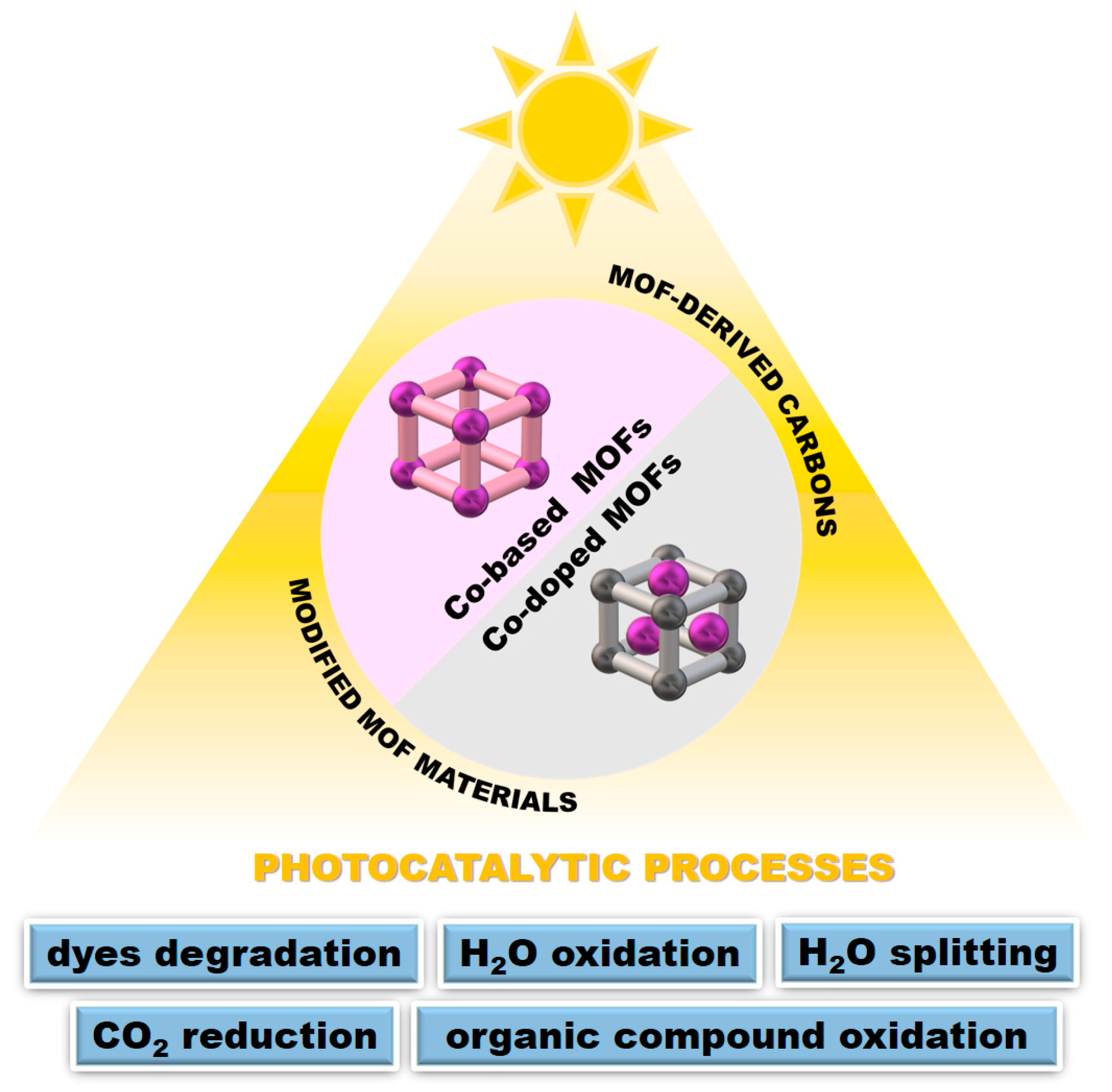
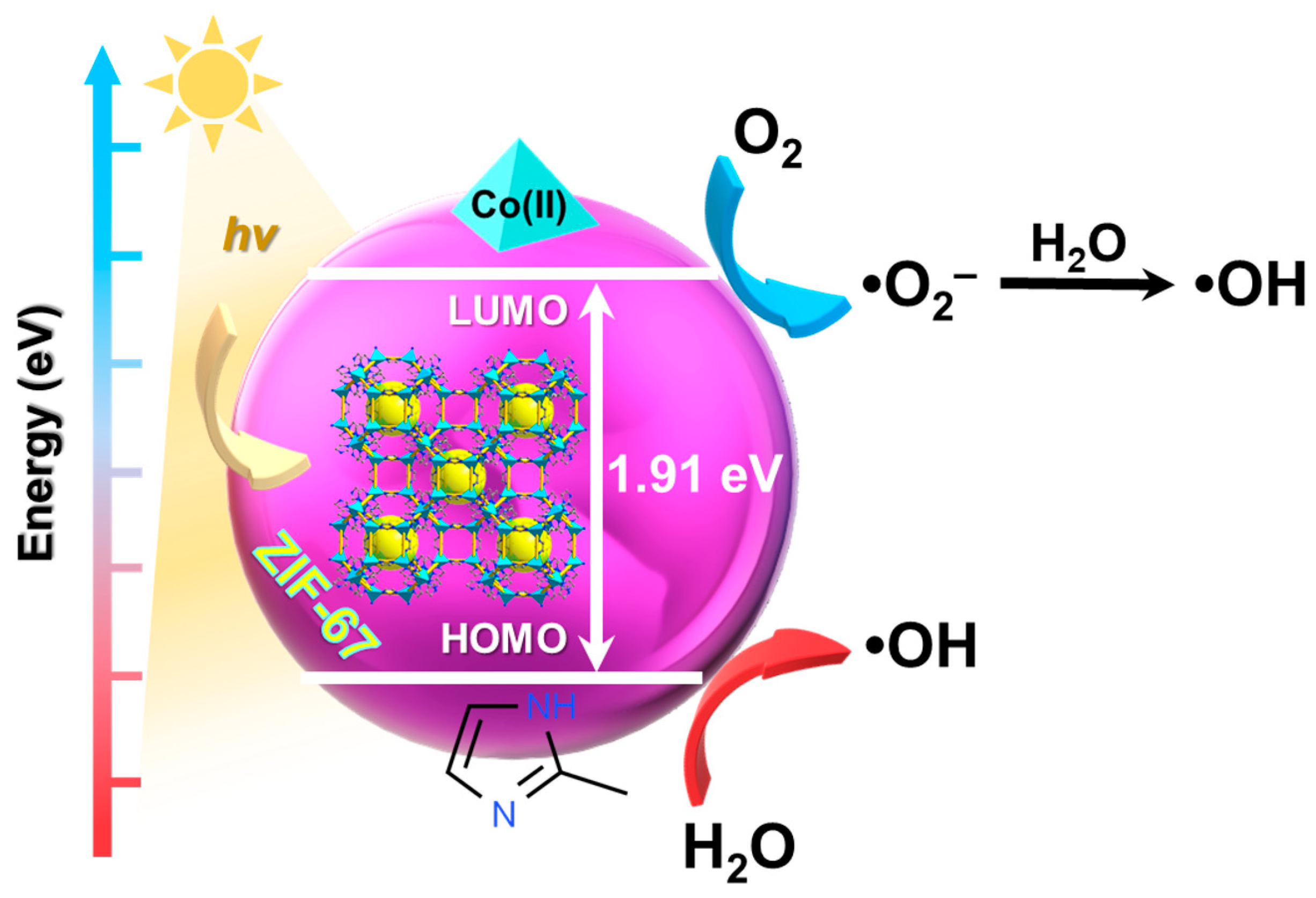
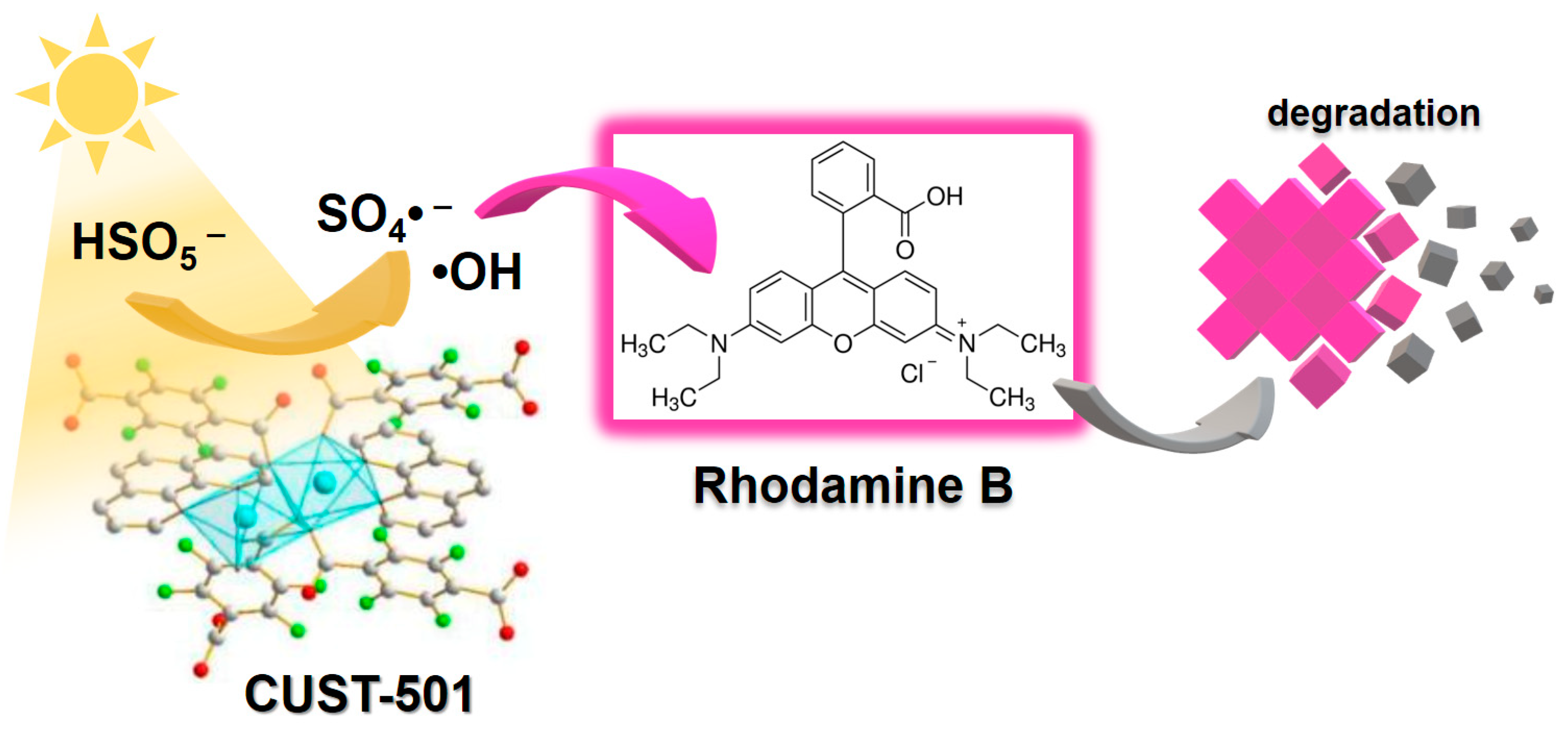
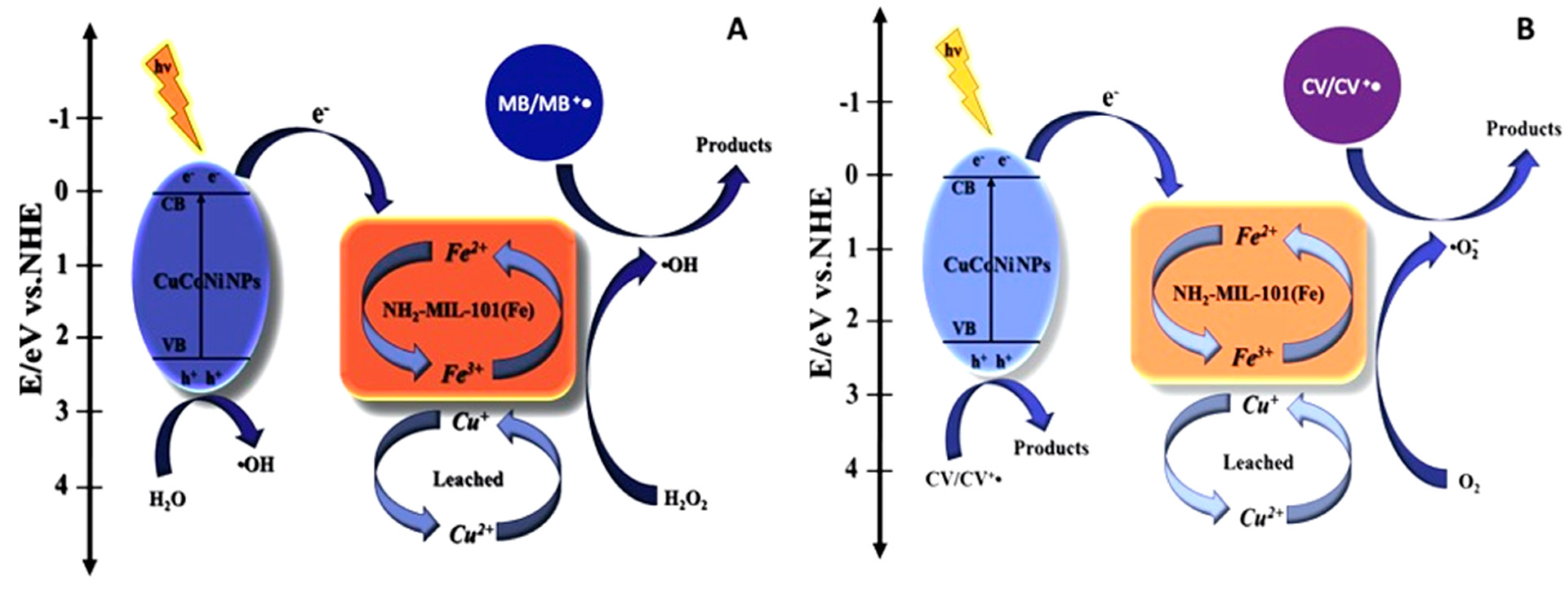




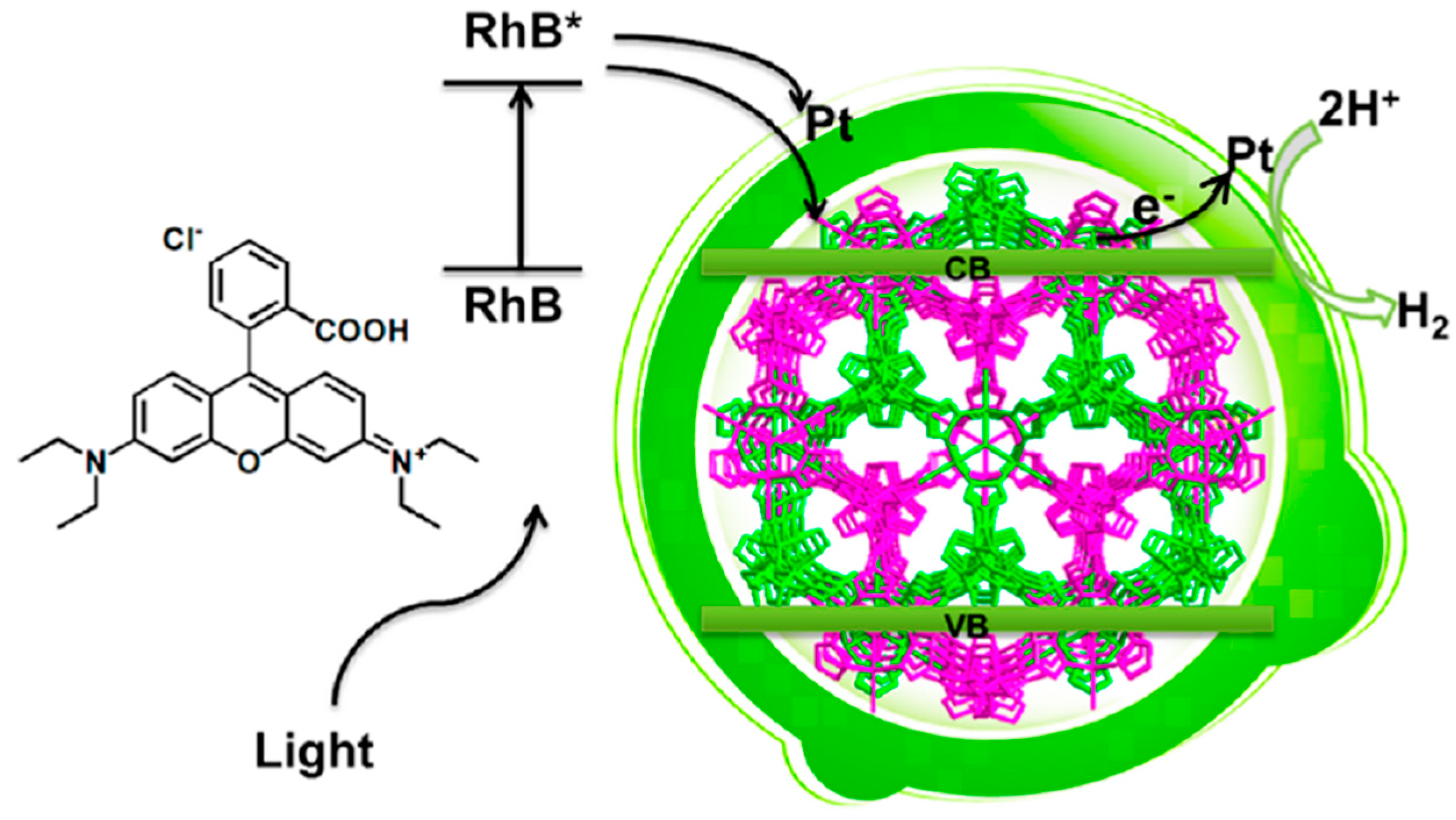
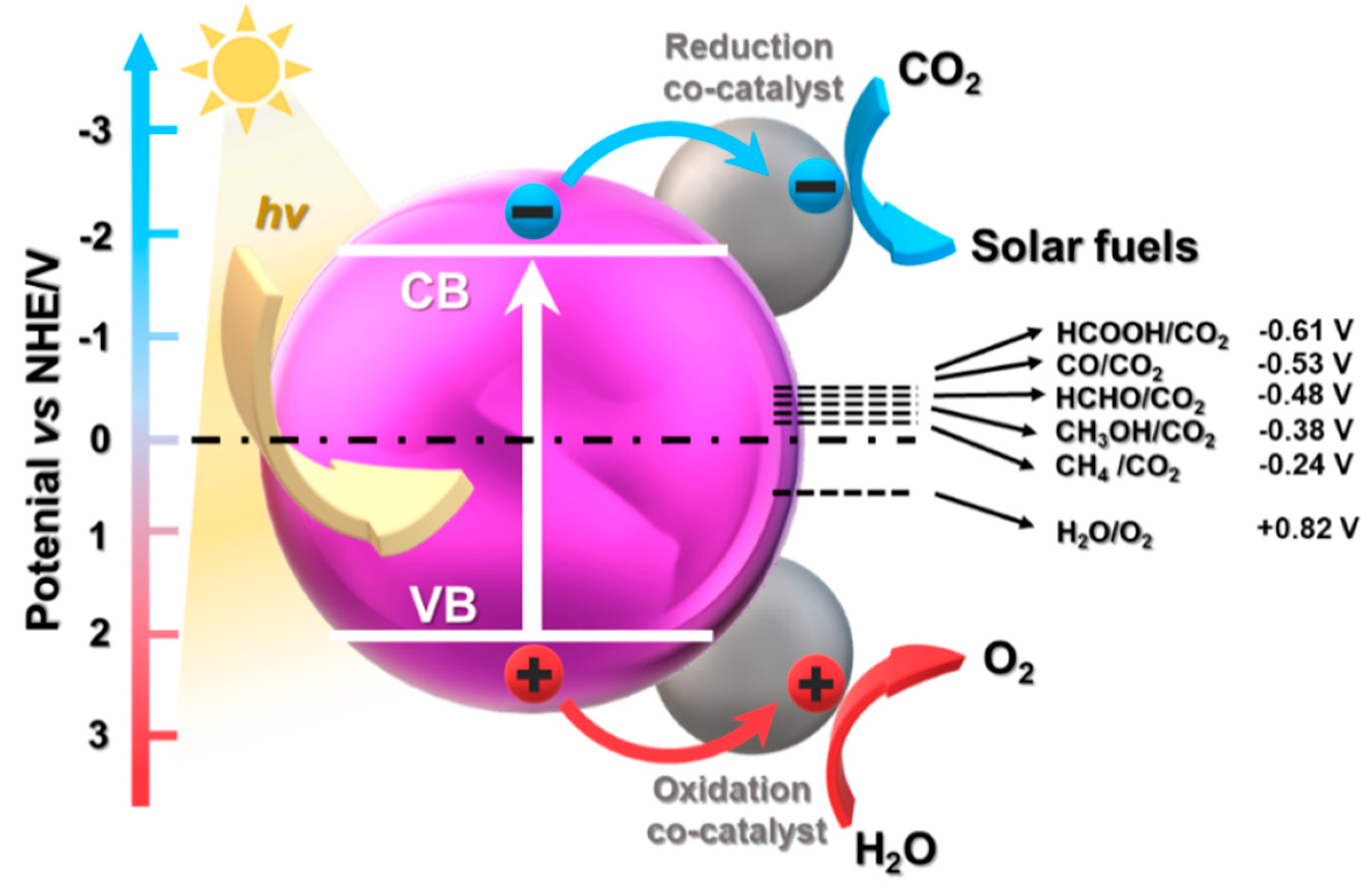
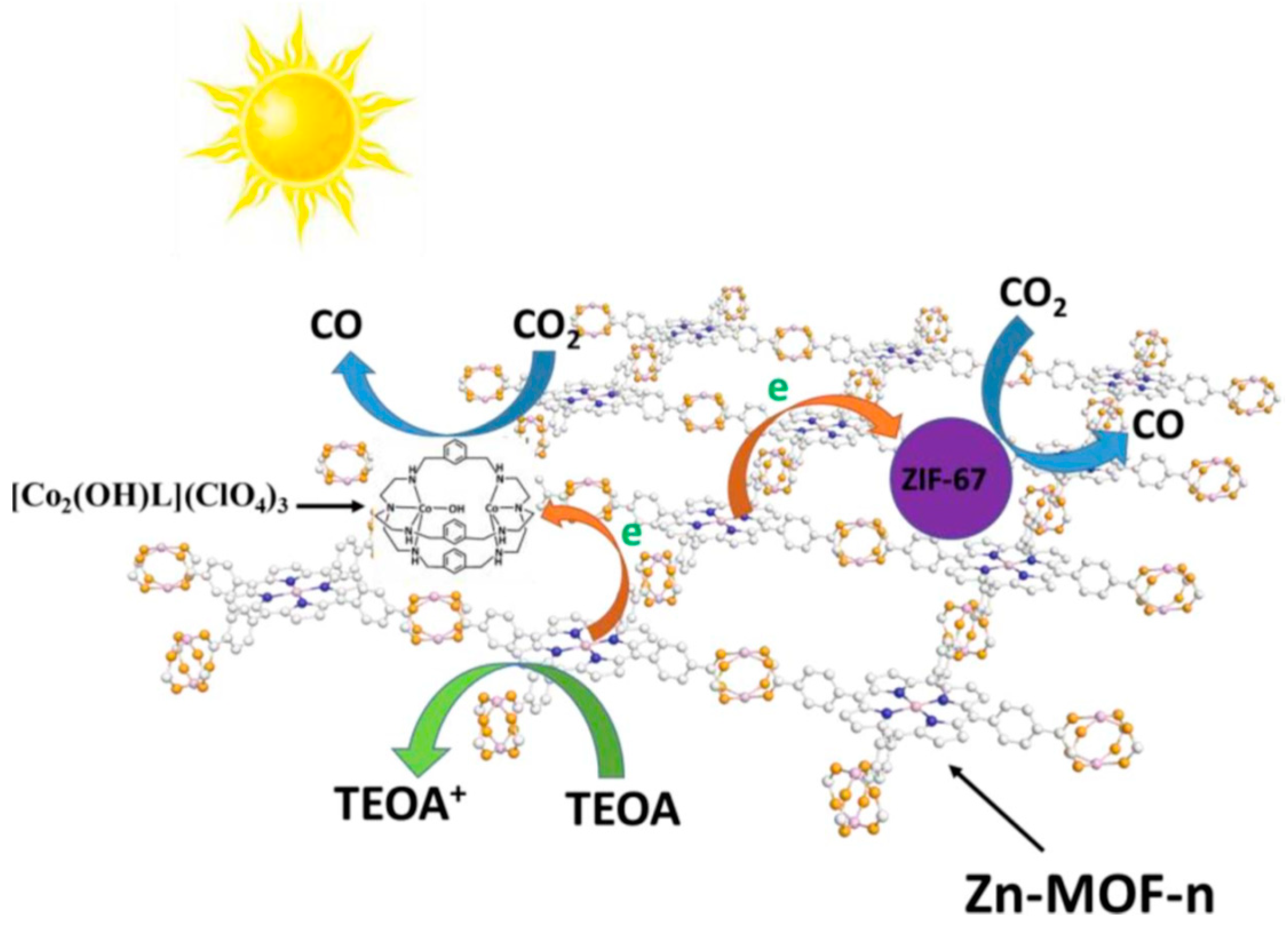
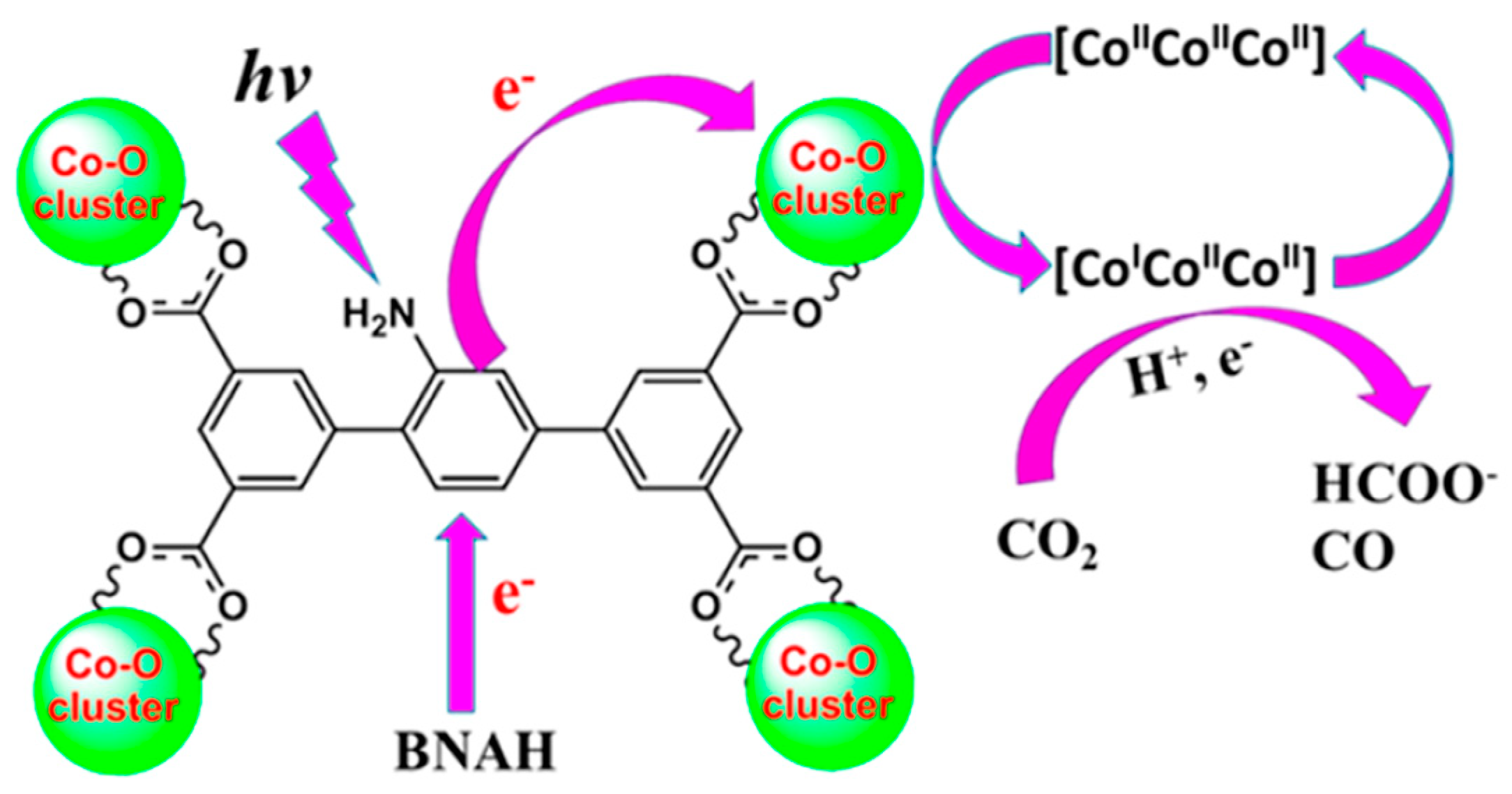
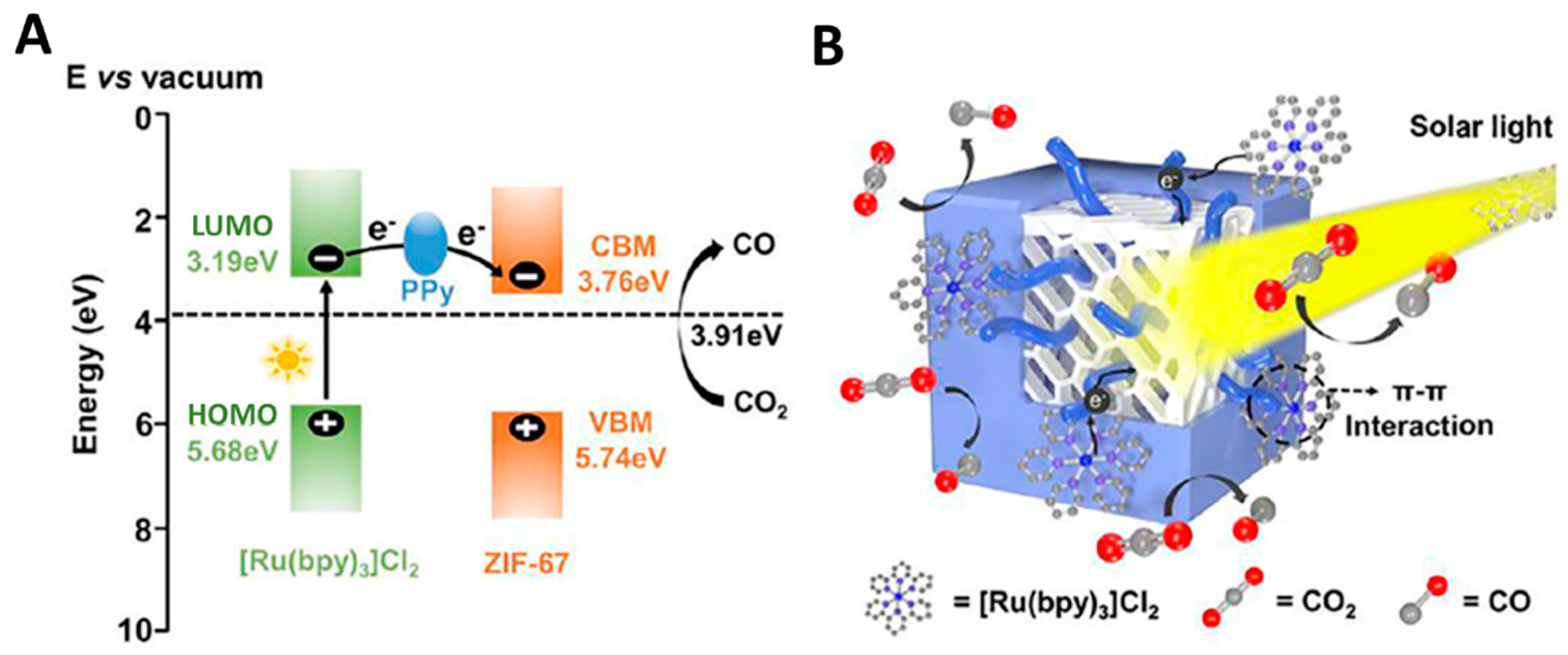
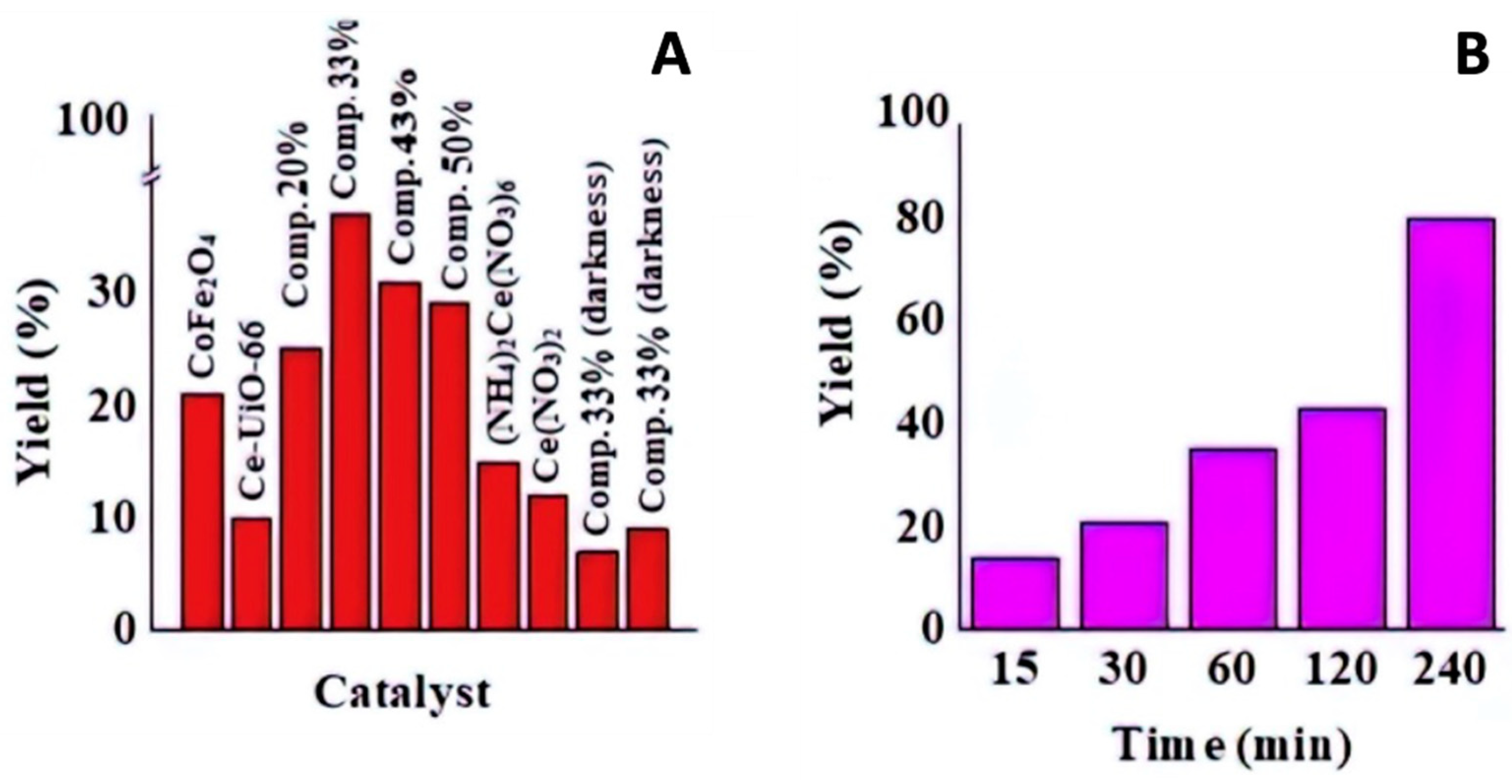
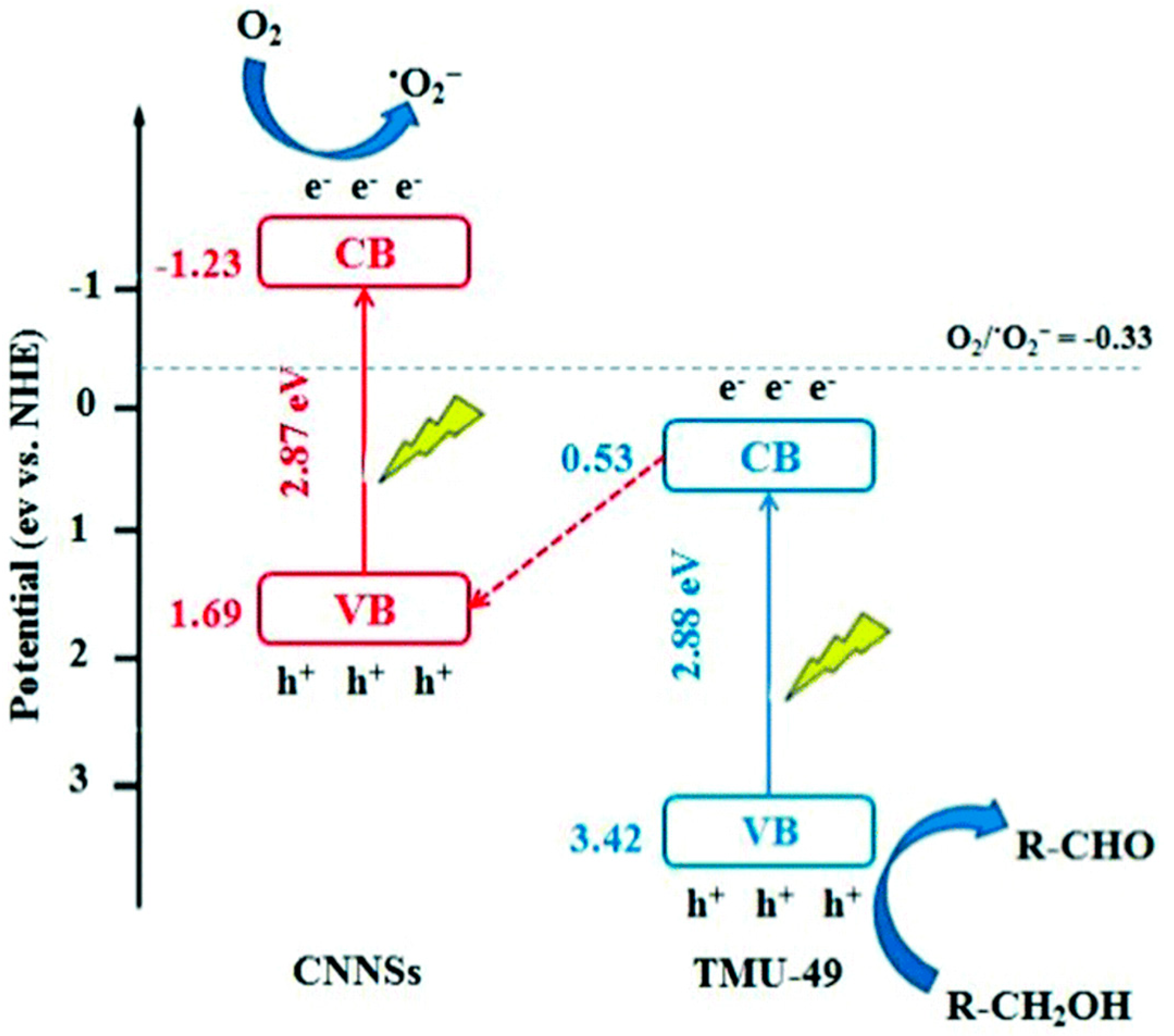
| Photocatalyst | Dye | Photodegradation Efficiency (%) | Time | Ref. |
|---|---|---|---|---|
| ZIF-67 | Methyl orange | ~88 | 1 h | [70] |
| ZIF-67(Ar) | Methyl blue | 85.7 | 1 h | [71] |
| Rhodamine B | 54.8 | 1 h | ||
| ZIF-67@CoWO4@CoS | Methylene blue | ~100 | 10 min | [72] |
| Co/Zn-ZIF | Indigo carmine | ~100 | ~3 h | [73] |
| [Co(L)(tib)(H2O)2]n | Methylene blue | 75.2 | 2 h | [74] |
| Methyl violet | 92.1 | 2 h | ||
| [Co(L)(bip)0.5]n | Methylene blue | 57.7 | 2 h | [74] |
| Methyl violet | 89.7 | 2 h | ||
| [Co4(bbibp)5(HCOO)8(H2O)2]n | Methylene blue | ~100 | 75 min | [75] |
| Methyl violet | 49.2 | 75 min | ||
| Rhodamine B | 39 | 75 min | ||
| [Co(bimmb)(NO3)2]n | Methylene blue | 94 | 75 min | [75] |
| Methyl violet | 68.7 | 75 min | ||
| Rhodamine B | 64.4 | 75 min | ||
| [Co4(μ3-OH)2(H2O)2(L)2 (bib)1.5(CH3CN) × 3H2O × CH3CN] | Methyl violet | 67.99 | 100 min | [76] |
| [Co8(μ3-OH)4(L)4 (bib)4 × 8CH3CN] | Methyl violet | 78.22 | 100 min | [76] |
| CUST-501 | Rhodamine B | 100 | 15 min | [77] |
| {[Co(tib)2(bimb)2] × 4H2O}n | Methylene blue | 92.1 | 2 h | [78] |
| Methyl violet | 89.3 | 2 h | ||
| {[Co2(bipa)4(bibp)6]}n | Methylene blue | 92.8 | 2 h | [78] |
| Methyl violet | 93.7 | 2 h | ||
| MO@Co-MOF | Eriochrome Black T | 92 | 4 h | [79] |
| MB@Co-MOF | Eriochrome Black T | 99.7 | 4 h | [79] |
| [Co(L)0.5(OBA)]n | Methylene blue | 93.8 | 135 min | [80] |
| NH2-MIL-101(Fe)@CuCoNi | Methyl blue | 99 | 2 h | [81] |
| Crystal violet | 93 | 2 h |
| Photocatalyst | TOF; TON; Generated Product Amount | Ref. |
|---|---|---|
| Phodo-driven water oxidation | ||
| ZIF-67 | TOF = 0.035 s−11 | [24] |
| Co4-bdt | TOF = 3.050 s−1 | [100] |
| ([CoIICoIIIW11O39(H2O)]−7@MIL-101 | TOF = 0.48 s−1 | [101] |
| [Co4(PW9O34)2(H2O)2]−10@MIL-101 | TOF = 0.53 s−1 | [101] |
| Cox/MIL-101 | TOF = 0.012 s−1 | [102] |
| P2W18Co4@MOF-545 | TOF = 0.040 s−1 | [103] |
| P2W18Co4@MOF-545 film | TON = 1600 | [104] |
| ZIF-67 | 9.8 µmol of O2 | [105] |
| Co-MOF-74@ZIF-67 | 15.0 µmol of O2 | [105] |
| Co-MOF-74 | 11.8 µmol of O2 | [105] |
| CoP@CoOx | 901.5 mmol g−1 h−1 of O2 | [112] |
| Photoelectrocatalytic (PEC) water splitting for hydrogen generation | ||
| ZIF-67 film | 48.5 μmol g−1 of H2 | [124] |
| Cox/NH2-MIL-125(Ti) | TOF = 0.8 h−1 | [126] |
| Co3-XL | 23.05 µmol g−1 h−1 of H2 | [127] |
| (Co0.5[Ru(tpyCOO)2]PF6) | 589 μmol g−1 h−1 of H2 | [128] |
| Co4S3/CdS | 12 360 µmol g−1 h−1 of H2 | [129] |
| Photocatalyst | TOF; TON; Generated Product Amount | Selectivity over H2 Evolution | Ref. |
|---|---|---|---|
| [Co2(μ-OH)2(btdd)] | TOF = 0.059 s−1 | 98.2% | [147] |
| Zn-MOF/Co-complex | TON = 68.7 | 81.5% | [148] |
| Zn-MOF/ZIF-67 | TON = 117.8 | 91.0% | [148] |
| Co-POR | 0.4 µmol g−1 h−1 of CO | - | [149] |
| MOF-525-Co | 200 µmol g−1 h−1 of CO 36.67 µmol g−1 h−1 of CH4 | - | [151] |
| Co-ZIF-9 | TOF = 450 within 2.5 h 83.6 µmol h−1 of CO | - | [152] |
| g-C3N4@Co-ZIF-9 | TON = 35 | - | [153] |
| Cd@Co-ZIF-9 | 85.6 µmol of CO | 91.2% | [154] |
| Co1Ni2-MOF | 1160 µmol g−1 h−1 of CO | 94.6% | [155] |
| Co-C3N4 | 464.1 μmol g−1 h−1 of CO | - | [156] |
| trinuclear CoIICoIICoII MOF | 456.0 μmol g−1 h−1 of HCOO− | 61 | [157] |
| ZIF-67 | TON = 112 32.7 μmol of CO | - | [158] |
| ZIF-67@a-TiO2 | 43.8 μmol of CO | 67.2% | [159] |
| PPy-ZIF-67 | 59.42 μmol of CO | - | [160] |
| Photocatalyst | Compound | Conversion Efficiency [%] | Time | Ref. |
|---|---|---|---|---|
| Fe3O4@Ni–Co-BDC NPs | Benzyl alcohol | 87 | 3 h | [162] |
| 4-methylbenzyl alcohol | 93 | 3 h | ||
| 4-methoxybenzyl alcohol | 98 | 3 h | ||
| 3-methoxybenzyl alcohol | 90 | 3 h | ||
| h-Co-MOF-74 | Thioanisole | 100 | 10 h | [164] |
| 4-bromothioanisole | 100 | 10 h | ||
| 4-fluorobenzaldehyde | 100 | 10 h | ||
| Methyl p-tolyl sulphide | 100 | 10 h | ||
| 4-chlorothioanisole | 100 | 10 h | ||
| TMU-22(Zn/Co) | Benzyl alcohol | 65 | 3 h | [165] |
| CoFe2O4/Ce-UiO-66 | n-hexanol | ~80 | 4 h | [166] |
| 3-nitrobenzyl alcohol | 90 | 6 h | ||
| 4-nitrobenzyl alcohol | 90 | 6 h | ||
| 4-bromobenzyl alcohol | 82 | 6 h | ||
| TMU-49/CNNSs | Benzyl alcohol | 81 | 4 h | [167] |
| 4-nitrobenzyl alcohol | 83 | 3 h | ||
| 4-bromobenzyl alcohol | 91 | 3 h | ||
| 4-methylbenzyl alcohol | 76 | 3 h | ||
| 4-methoxybenzyl alcohol | 45 | 3 h |
Publisher’s Note: MDPI stays neutral with regard to jurisdictional claims in published maps and institutional affiliations. |
© 2022 by the authors. Licensee MDPI, Basel, Switzerland. This article is an open access article distributed under the terms and conditions of the Creative Commons Attribution (CC BY) license (https://creativecommons.org/licenses/by/4.0/).
Share and Cite
Ejsmont, A.; Jankowska, A.; Goscianska, J. Insight into the Photocatalytic Activity of Cobalt-Based Metal–Organic Frameworks and Their Composites. Catalysts 2022, 12, 110. https://doi.org/10.3390/catal12020110
Ejsmont A, Jankowska A, Goscianska J. Insight into the Photocatalytic Activity of Cobalt-Based Metal–Organic Frameworks and Their Composites. Catalysts. 2022; 12(2):110. https://doi.org/10.3390/catal12020110
Chicago/Turabian StyleEjsmont, Aleksander, Agata Jankowska, and Joanna Goscianska. 2022. "Insight into the Photocatalytic Activity of Cobalt-Based Metal–Organic Frameworks and Their Composites" Catalysts 12, no. 2: 110. https://doi.org/10.3390/catal12020110
APA StyleEjsmont, A., Jankowska, A., & Goscianska, J. (2022). Insight into the Photocatalytic Activity of Cobalt-Based Metal–Organic Frameworks and Their Composites. Catalysts, 12(2), 110. https://doi.org/10.3390/catal12020110







